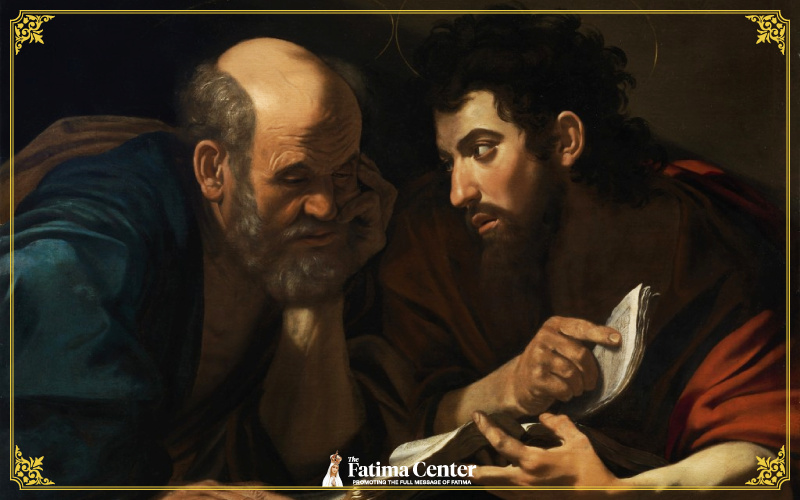The first catalog of Holy Days of Obligation comes from the Decretals of Gregory IX in 1234, which listed 45 Holy Days. In 1642, His Holiness Pope Urban VIII issued the papal bull Universa Per Orbem, which altered the required Holy Days of Obligation for the Universal Church to consist of 35 such days as well as the principal patrons of one’s locality. In that listing, Ss. Peter and Paul was listed as a Holy Day of Obligation.
In fact, all of the feasts of the Apostles were Holy Days of Obligation on the Universal Calendar from 932 AD – as cited by Father Weiser on page 279 in his Christian Feasts and Customs – to 1911 AD. However, most localities did not observe all of these feast days as Holy Days. The Feast of Ss. Peter and Paul was the most commonly observed Holy Day among the feasts of the Apostles. Even after the changes to Holy Days of Obligation in Ireland in the mid-1700s, Ss. Peter and Paul remained a day of double precept.
At the time of America’s formation, the Holy Days of Obligation, in addition to every Sunday, were as follows for the new country: the feasts of Christmas, Circumcision, Epiphany, Annunciation, Easter Monday, Ascension, Whitsun Monday, Corpus Christi, Ss. Peter and Paul, Assumption, and All Saints. But even though these were the “official” Holy Days, practices varied across the dioceses in the United States as there was no uniformity until 1885.
In 1722, Bishop Giffard, the Vicar Apostolic of London, approved a dispensation “on behalf of the mission of Maryland for the ease and quiet of poor Catholics of that Mission” to sanction a dispensation of Holy Days. He granted the Maryland Superior the faculties to dispense Catholics from Holy Days and fasting obligations. As American Catholic Quarterly Review notes, “Bishop Giffard permitted the Jesuits to dispense Catholics in Maryland, Virginia, and Pennsylvania from the obligations of all holy days for just cause, e.g., getting in crops at harvest, between May 1 and September 30, respect for the feasts of Ascension, Easter Monday, Corpus Christi, and Assumption.”
On March 9, 1777, Pope Pius VI “dispensed all Catholics in the kingdom of Great Britain from the precept of hearing Mass and abstaining from servile works on all Holy Days except the Sundays of the year, the feasts of Christmas, Circumcision, Epiphany, Annunciation, Easter Monday, Ascension, Whitsun Monday, Corpus Christi, St Peter and St Paul, Assumption, and All Saints.” As the Catholic Dictionary of 1861 further states: “The Vigils of the Feasts thus abrogated his Holiness transferred to the Wednesdays and Fridays of Advent, on which he ordered that fast should be kept as in Lent or Embertide, ‘although it is an English custom to keep fasts and vigils on Friday.’ The pope adds a power to the Vicars Apostolic to dispense from the precept of abstaining from servile works on SS. Peter and Paul falling in the hay-harvest, and the Assumption in the wheat-harvest, provided Mass has been previously heard, if possible.”
And Ss. Peter and Paul seemed to have been dispensed for those Catholics in the Archdiocese of Baltimore, America’s first Archdiocese. An 1818 Ordo for the Metropolitan Archdiocese of Baltimore does not list Ss. Peter and Paul as a required day of precept.
Before 1885, Holy Days varied within various jurisdictions in the United States. Those formerly French colonies (which followed the Holy Days as set by Quebec) differed from the English. This disunity continued for the young United States since new territories (e.g., Florida, Texas, and Oregon) did not follow the same Holy Days of Obligation and the same fasting days.
In 1840, Pope Gregory XVI dispensed the remaining dioceses then in the United States from keeping Ss. Peter and Paul as a Holy Day of Obligation. Permission, however, was granted to the United States on December 19, 1840, to solemnize the Feast of Ss. Peter and Paul the Sunday following June 29th. Such permission had already been given to the French by Pope Pius VI on April 9, 1802 for this Feast day in addition to Epiphany, Corpus Christi, and the “principal patrons of the place”.
In fact, it was a requirement for priests in the United States to continue to solemnize the feast on the following Sunday – a requirement that continued even through the 1962 Missal. Matters Liturgical from 1959 notes:
“The external solemnity of the feast of Corpus Christi must be transferred in the United States and celebrated on the Sunday following; this is also prescribed for the feast of SS. Peter & Paul (June 29), when this feast falls on a weekday (Indult of Nov. 25, 1885). Hence, where on Sundays the principal Mass is usually a sung Mass, on the Sundays following these feasts this sung Mass in churches and public oratories must, and in semi-public oratories may, be of the transferred external solemnity (S.R.C. 2974, IV; 4269, IX). This Mass shall be celebrated as on the feast, with only those occurring Offices to be commemorated as are noted in n. 209 f, even if the Mass is one of two or more different sung Masses, the rubrics in M.R.: ADD., v, 4 being now abrogated.”
Its observance as an external solemnity in other nations (e.g., France) is optional. As such, liturgists like Father J.B. O’Connell do not mention this requirement in his rubrics for Votive Masses as he did not write from an American perspective.
Despite these changes over the centuries, the fact that so many observed Ss. Peter and Paul as a Holy Day for so long underscores our own need to keep this day holy, to attend the external solemnity of Ss. Peter and Paul, and our need to keep the Vigil of Ss. Peter and Paul as a day of fasting and abstinence.




